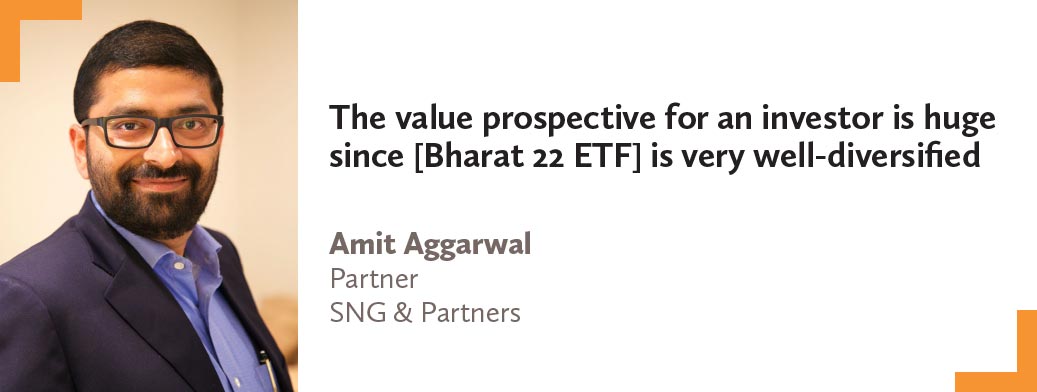A new fund – Bharat 22 ETF – has boosted the government’s disinvestment programme. Who were the legal advisers and what was their role? Rebecca Abraham reports
The “government has no business to be in business”, has been a refrain often heard from Prime Minister Narendra Modi. This mantra was recently repeated by Amitabh Kant, a former bureaucrat who wields substantial clout as the head of Niti Aayog, a policy think-tank of the government, who advocated that the government should also hand over schools, colleges and prisons to the private sector.
Be that as it may, the central government’s disinvestment programme focuses on the roughly 235 public sector enterprises that it controls. The vehicle of choice for disinvestment – as mentioned in the finance minister’s budget speech earlier this year – continues to be the exchange traded fund (ETF).
WALKING THE WALK
The government first used an ETF to disinvest in March 2014. Dubbed the CPSE (Central Public Sector Enterprises) ETF, it netted the government nearly ₹115 billion (US$ 1.9 billion).
When the government’s second all-equity ETF, the Bharat 22 ETF, closed on 17 November it was oversubscribed four times. This prompted it to raise the issue size to US$2.2 billion from the US$1.2 billion initially envisaged. It is now being hailed as the largest new fund offer in the history of India’s mutual fund industry.
Units of the Bharat 22 ETF, which tracks the performance of the 22 listed companies that it comprises, listed on the BSE and the National Stock Exchange of India on 28 November. The Department of Investment and Public Asset Management of the Ministry of Finance consequently successfully reduced its stake in the 22 companies.
“The value prospect for an investor is huge since it is very well-diversified” remarks Amit Aggarwal, a New Delhi-based partner at SNG & Partners, who led the firm’s team that advised the government on the transaction.
You must be a
subscribersubscribersubscribersubscriber
to read this content, please
subscribesubscribesubscribesubscribe
today.
For group subscribers, please click here to access.
Interested in group subscription? Please contact us.
你需要登录去解锁本文内容。欢迎注册账号。如果想阅读月刊所有文章,欢迎成为我们的订阅会员成为我们的订阅会员。
LEGAL ADVISERS
Department of Investment and Public Asset Management, Ministry of Finance
- Domestic legal adviser: SNG & Partners with partner Amit Aggarwal and senior associate Aditya Vikram Dua
- International legal adviser: Perkins Coie with partner Bobby Majumder
ICICI Prudential Asset Management
- Cyril Amarchand Mangaldas with partner Shagoofa Rashid Khan
- In-house legal team headed by Supriya Sapre, head, compliance and legal
Kotak Mahindra Capital
- Cyril Amarchand Mangaldas with partner Gokul Rajan
ORIGINAL AND UNIQUE
In a recent interview with The Hindu, the global head of exchange- traded products at S&P Dow Jones Indices, John Davies, described the Indian government’s use of ETFs for pursuing its disinvestment agenda as “original and unique”. According to Davies, “in no other market has the government used ETFs in such a way”.
The first ETF for this purpose was issued in March 2014 by the Manmohan Singh-led United Progressive Alliance government. The CPSE ETF comprises shares in 10 public sector enterprises including ONGC, Coal India and GAIL India and netted the government nearly US$1.9 billion. A second and third tranche of this energy-heavy ETF was issued in January and March of this year.
CPSE ETF is managed by Reliance Nippon Life Asset Management.
Diversified offering
Bharat 22 ETF has a wider sectoral coverage. It comprises central government held shares in 19 public sector enterprises including ONGC, State Bank of India, Indian Oil Corporation, National Aluminium Company, Bharat Petroleum Corporation and Bank of Baroda, as well as its holding in three private sector blue-chips – ITC, Axis Bank and Larsen & Toubro.
The shares of the three private sector companies currently account for 39% of the S&P BSE Bharat 22 Index, which is the underlying index of the fund. The weightage of each individual stock in the ETF is capped at 15% and each sector at 20% of the index. Bharat 22 ETF is managed by ICICI Prudential Asset Management.
Recent reports state that the government is looking to list Bharat 22 ETF internationally, following its success in India.




























